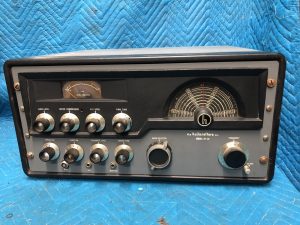Today, I would like to take a look at what might or might not be working after a speculative EMP event regardless if it’s a manmade or natural based disaster. I think there is a lot of speculation about the types of gear, vehicles, electronics, etc. that may or may not be working post EMP. However, what I think you will notice is that there are similarities in what may or may not work. Let’s take a look:
Planes, Trains, and Automobiles (specifically automobiles)
 As any self-professed prepper knows that is interested in preparing for an EMP event, your vehicle may or may not be affected depending on the make, model, year, etc. where it’s parked, what it’s covered with (we’ll get in to that in a second) that gets hit by such an event. Really, I am not an expert and do not profess to be; but want to share what I understand would be the most likely case if you needed or wanted to have a vehicle post EMP event. That said if your car or truck was built before 1990, and more specifically, if it was pre-1980 would be ideal…
As any self-professed prepper knows that is interested in preparing for an EMP event, your vehicle may or may not be affected depending on the make, model, year, etc. where it’s parked, what it’s covered with (we’ll get in to that in a second) that gets hit by such an event. Really, I am not an expert and do not profess to be; but want to share what I understand would be the most likely case if you needed or wanted to have a vehicle post EMP event. That said if your car or truck was built before 1990, and more specifically, if it was pre-1980 would be ideal…
Example: I personally own a 1990 Jeep Wrangler YJ which has a computer. From 1987 forward, I believe they all have computers and electronics of some sort. The Jeep won’t run correctly without a properly programmed computer. As I understand it, these are the only electronics in the vehicle and contained in one package that can be unplugged and a new one plugged in. All I need to do is buy a couple of refurbished computers, have them programmed for my Jeep, keep them in a faraday cage (presumably) and in the event of an EMP, unplug the old computer, and plug in the faraday cage kept computer. I do not believe (and I could be wrong) there are any electronics in the alternator or other components of the Jeep of that year. If there are, if someone could point that out, it would be helpful so that I can get spare parts in the Faraday Cage. But, this is as I understand it.
Today, however, my 20XX Toyota 4Runner is full of electronics. And I mean full. I don’t think the car will start at all if there’s an EMP event. With all the reliance on separate computers for various activities, it would be like the car had a fatal heart attack while sleeping. The best thing I think I could do at that point would be to drain the gasoline, salvage what I could off the car, and move on to the what is important to my family and myself at that time. My wife’s car would be in the same boat. Drain the gasoline, and strip what might be essential or secondary prep/concern and move on to what’s important.
There is a theory that some vehicles would still be able to start, where some electronics may not be affected, and some would be. See the video from Arthur T Bradley, PHD (also the Author of The Survivalist series) as he speculates how this may or may not work. I look to Dr. Bradley as an authority of sorts because he actually an EMP Emitter at his disposal for testing purposes, as you will see regarding the EMP cloth he discusses in his video… However, the downside of all those new cars on the road, especially in the NYC, NJ, Eastern PA area where we are located is that there will be giant modern-day boulders acting as roadblocks on the highways and side roads… And if an event were to take place at rush hour, forget it. It’s not a boulder, it’s a long tail of not being able to get anywhere.
That said, if you are preparing a vehicle for an EMP event, I suggest go pre 1990, and preferably pre 1980, even if it’s a 1976 Buick Station Wagon. You’ll still be better off than me at the moment. (It really is time to look at a couple refurbished computers for the Jeep, and keep one in a faraday cage in the makeshift trunk).
ATVs and Motocross Bikes. One of the guys in our crew has an ATV. He loves it. Hell, I love it. It goes everywhere. However, I am pretty sure, and I have to ask him, that there are no electronics that it contains that would be hit by an EMP event. The same goes for an old endure motocross motorcycle (think kickstart). If you’re lone wolfing it, a motorcycle might be a safe bet. I know because we used to communicate via Email, after I read several of his books that Scott Williams over at Bug Out Survival wrote about his first-hand experience with Motorcycles as Bug Out Vehicles in his book “Bug Out Vehicles and Shelters” To that end, Creek Stewart, also wrote an excellent book on Bug Out Vehicles called “Build the Perfect Bug Out Vehicle: The Disaster Survival Vehicle Survival Guide,” and if I remember correctly, he also touched on the EMP based points I speak about above.
Last thoughts on Diesel Vehicles before I forget. What I know about Diesel vehicles can fill a thimble, and I’ll fill that thimble up for you… Most modern diesel trucks (the 2000’s) run with computers/chips that help regulate sensors, etc. My “understanding” however is that those trucks use those sensors, etc. for regulating emissions and other points in the vehicle, that with some planning and ingenuity can probably be removed or disabled to make that vehicle more mechanically operable than electronically operable. This is something I understand that might be near impossible with modern gasoline vehicles. The other option, if you know what you are doing and because there are not that many areas to be addressed is to hit a scrap (junk) yard, and load up on the sensor computers/microprocessors that you would require and keep them in a Faraday cage until you might need them. There, you’ve got a full thimble from me on what I know about Diesel. I am happy to hear commentary from anyone with more experience in this area to share with the greater community. (Oh, and if I’m wrong, please let me know that too. I am human).
Electronics
 Well, you now know your Pioneer Radio that interfaces with your iPhone or Android phone aren’t going to be working after an EMP event. You also know that you’re car will “most likely” not run after an EMP Event. But, what of other electronics you may or may not have in your home. Your old mechanical record player that sits in the back closet from when you were a kid? What about an old radio or ham radio for that matter that runs on tubes and not electronics??? Firstly, everything you have in your faraday cage “should” work fine. Your Motorola two way radios, your Baofeng Handheld Radios, your old iPod, with your classic rock on it (assuming the battery isn’t permanently dead), the extra Amazon Kindle you have in there with your electronic survival library on it, etc. All those items should work…
Well, you now know your Pioneer Radio that interfaces with your iPhone or Android phone aren’t going to be working after an EMP event. You also know that you’re car will “most likely” not run after an EMP Event. But, what of other electronics you may or may not have in your home. Your old mechanical record player that sits in the back closet from when you were a kid? What about an old radio or ham radio for that matter that runs on tubes and not electronics??? Firstly, everything you have in your faraday cage “should” work fine. Your Motorola two way radios, your Baofeng Handheld Radios, your old iPod, with your classic rock on it (assuming the battery isn’t permanently dead), the extra Amazon Kindle you have in there with your electronic survival library on it, etc. All those items should work…
If, you have access to old ham radio with tubes, a short-wave radio with tubes, anything that is tube based you may be okay if it’s not already broken. Tube-based systems are not “electronic” in nature and should not be affected by an EMP. As I understand it (and this is hearsay from another video I watched) that during the 1950s when the government was testing nuclear devices and the EMP effect was being studied, they realized that their tube-based platforms were not damaged by the EMP effect. Of course, buying these old tube-based devices sounds good in theory. They’re not inexpensive, but you also need to have electricity in order to run them, and, those that have devices in a Faraday cage have to have a way to charge their devices in order to continue to keep them working. More on that later in this post. This is just some food for thought on electronics.
What are some electronics you might want to keep in your Faraday Cage:
- An electronic copy of all your critical family records on a thumb drive
- Laptop(s) with tools (documents) you may want to recall
- External Hard Drive for your music, pictures, and extended survival library of videos, audio, and PDFs
- Tablet (iPad, Android device, or Kindle Reader)
- Shortwave radio
- FRS/GMRS Radios
- Handheld Ham Radios
- iPods or MP3 Players for entertainment purposes
- Bluetooth or battery powered speaker for your iPod or MP3 Player
- Battery powered HDTV/DVD Player
- Headphones
- Chargers for MP3 Players, Laptops, etc.
- Solar Charge Controller for any solar platform you are using to charge batteries
- Inverter(s) as these typically use electronics
- Emergency NOAA/Radio
- Extra computer for your car (in my case my Jeep)
- What else can you think of and pipe up in the comment section…
Power Tools (without Electronics)
It’s no secret we men like our power tools. I love’em, and wouldn’t work around the house ever without at least my cordless drill… Most cordless drills driven by a battery have some microelectronics embedded to regulate power, speed, etc. So unless you are keeping any of them and their batteries, and chargers in a Faraday cage, an EMP would most likely render a such a cordless device useless. However, there are a number of tools that are driven by electrical power that you can use that have no electronics in them at all. I have an old electric corded power drill that has no electronics, and assuming my battery backup and/or generator is running, I’ll be good to go in the short term. This, however, should not be the only route you go. You should think about manual tools (manual drills, planers, etc) to take the place of those tools that may have electronics in them today. If we get fried by an EMP, manual tools may be the only way to get something done, repaired or built.
Basic motor driven tools such as push lawn mowers that pull start, should not be affected. However, if you have a generator with an inverter built in, then we have to chat about electronics which may be included in that inverter, that “may be” be affected during an EMP event. Unless your generator is in a faraday cage today, you might want to look at the EMP proof fabric to cover your generator as described in the video earlier in this blog post.
A note on flashlights. I’m pretty sure most modern preppers adhere to some sort of EDC regimen. Meaning, you carry a pocket knife, pen, wallet, keys, phone, maybe you conceal carry (if you don’t live in an overbearing state), and probably carry a flashlight… And, I’ll go out on a limb and say it’s an oLight, Fenix, ATACTICAL (this is what I carry and I cannot kill the thing for a $20 flashlight) or some other brand. The downside of all these tactical lights? They all have some microelectronics in them to control the brightness or the strobe. In fact, the ATACTICAL light that I own came with a battery with a micro-USB charger that plugs right into the battery to recharge it. Sigh, more microelectronics. It would be smart to keep a few of these flashlights in your faraday cage and invest in a flashlight or several that do not have electronics. The downside here is you may have to go back to a light that has a regular light bulb and a slide on and off vs. the sleek and tacticool look of the lights we carry today.
Power: Solar Panels and Solar Systems
 “If” you have a solar system set up, it is also “speculated” that most solar panels will stand up to an EMP event. Some may have electronics on the backsides that daisy chain in parallel or series to additional panels, but as I understand it (again, what I know fills a thimble so any additional information would be greatly appreciated), may be okay. The caveat (hearsay again) is that there may be a reduction in output (not sure why) though, unless something on the system back-feeds to a panel and there is some sort of burn out. Not really sure. One thing is certain however, and that is that your charge controller will be fried, because it is full of electronics that regulate the power going to the battery bank, keeping it from back-feeding, and halting the charging to a trickle when the batteries are full as to not overcharge them and keep them topped off. Depending on the size and scope of your solar system you should keep one or two of these in your faraday cage, especially if you have a one – five-panel system with a couple batteries that is portable. If you’re bugging out in a camper or other bug out vehicle and you can bring some portable power, you know how important it can be.
“If” you have a solar system set up, it is also “speculated” that most solar panels will stand up to an EMP event. Some may have electronics on the backsides that daisy chain in parallel or series to additional panels, but as I understand it (again, what I know fills a thimble so any additional information would be greatly appreciated), may be okay. The caveat (hearsay again) is that there may be a reduction in output (not sure why) though, unless something on the system back-feeds to a panel and there is some sort of burn out. Not really sure. One thing is certain however, and that is that your charge controller will be fried, because it is full of electronics that regulate the power going to the battery bank, keeping it from back-feeding, and halting the charging to a trickle when the batteries are full as to not overcharge them and keep them topped off. Depending on the size and scope of your solar system you should keep one or two of these in your faraday cage, especially if you have a one – five-panel system with a couple batteries that is portable. If you’re bugging out in a camper or other bug out vehicle and you can bring some portable power, you know how important it can be.
That said, all modern inverters also contain electronics, and are susceptible to an EMP event, especially if they are in use. It would be smart to keep a spare inverter or two depending on the power needs you have to power lights, recharging devices, etc. and more.
This is my theory about what might still be running after a SHTF EMP event. Please register here and let us know what else you think may or may not still be running. We’d love to hear from you and get your thoughts on this.









Great article, thanks. I think we should all start taking our prepping even more seriously since I see this country going down the wrong road faster and faster than ever. Here are some useful resources you might want to check out:
25 Foods You Must Have in Your Prepper’s Pantry:
http://www.bestquicktips.com/shtfprepping
Prepper’s Corner Facebook Group:
https://www.facebook.com/Preppers-Corner-959288384091351/
10 things to do immediately after SHTF: https://youtu.be/vDQUEuTL8tk
Reading the book “One Second After” brought me here. All about EMP attack and what life could be like. Such a devastating possibility. Great to know others are thinking about it and what potential solutions, plans can be made. Can’t eliminate anxiety about all disasters but you can learn and try to prepare the best you can. Great stuff!